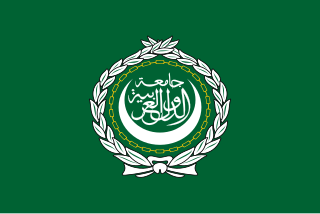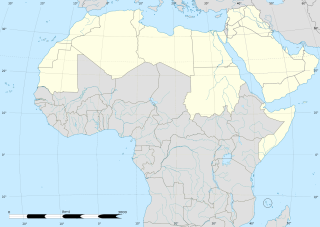
The Levant is an approximate historical geographical term referring to a large area in the Eastern Mediterranean region of Western Asia. In its narrowest sense, it is equivalent to the historical region of Syria, which included present-day Syria, Lebanon, Jordan, Israel, Palestine and most of Turkey south-east of the middle Euphrates. In its widest historical sense, the Levant included all of the Eastern Mediterranean with its islands; that is, it included all of the countries along the Eastern Mediterranean shores, extending from Greece to Cyrenaica in eastern Libya.

The Middle East is a transcontinental region in Afro-Eurasia which generally includes Western Asia, all of Egypt, and Turkey. The term has come into wider usage as a replacement of the term Near East beginning in the early 20th century. The broader concept of the "Greater Middle East" also includes the Maghreb, Sudan, Djibouti, Somalia, the Comoros, Afghanistan, Pakistan, and sometimes Transcaucasia and Central Asia into the region. The term "Middle East" has led to some confusion over its changing definitions.

North Africa is a region encompassing the northern portion of the African continent. There is no singularly accepted scope for the region, and it is sometimes defined as stretching from the Atlantic shores of Mauritania in the west, to Egypt's Suez Canal and the Red Sea in the east. Others have limited it to the countries of Algeria, Morocco, and Tunisia, a region that was known by the French during colonial times as "Afrique du Nord" and is known by Arabs as the Maghreb. The most commonly accepted definition includes Morocco, Algeria, Tunisia, Libya, Egypt, and Sudan, the 6 countries that shape the top North of the African continent. Meanwhile, "North Africa", particularly when used in the term Middle East and North Africa (MENA), often refers only to the countries of the Maghreb.

Sub-Saharan Africa is, geographically and ethnoculturally, the area of the continent of Africa that lies south of the Sahara. According to the United Nations, it consists of all African countries and territories that are fully or partially south of the Sahara. While the United Nations geoscheme for Africa excludes Sudan from its definition of sub-Saharan Africa, the African Union's definition includes Sudan but instead excludes Mauritania.

The Arab League, formally the League of Arab States, is a regional organization in the Arab world, which is located in Africa and Western Asia. The Arab League was formed in Cairo on 22 March 1945 initially with six members: Egypt, Iraq, Transjordan, Lebanon, Saudi Arabia, and Syria. Yemen joined as a member on 5 May 1945. Currently, the League has 22 members, but Syria's participation has been suspended since November 2011.

The Horn of Africa (HoA) is a peninsula in Africa. It lies along the southern side of the Red Sea and extends hundreds of km into the Gulf of Aden, Somali Sea and Guardafui Channel. The area is the easternmost projection of the African continent. Referred to in ancient and medieval times as the land of the Barbara and Ethiopians*, the Horn of Africa denotes the region containing the countries of Djibouti, Eritrea, Ethiopia, and Somalia.

The Arab world, formally the Arab homeland, also known as the Arab nation, the Arabsphere, or the Arab states, consists of the 22 Arab countries which are members of the Arab League. A majority of these countries are located in Western Asia, North Africa, and the Horn of Africa; the southernmost member, the Comoros, is an island country off the coast of East Africa. The region stretches from the Atlantic Ocean in the west to the Arabian Sea in the east, and from the Mediterranean Sea in the north to the Indian Ocean in the southeast. The eastern part of the Arab world is known as the Mashriq, and the western part as the Maghreb. Arabic is used as the lingua franca throughout the Arab world.

East Africa or Eastern Africa is the eastern subregion of the African continent, variably defined by geography. In the United Nations Statistics Division scheme of geographic regions, 20 territories make up Eastern Africa:

Somalis are an East Cushitic ethnic group belonging to the Cushitic peoples native to Greater Somalia. who share a common Somali ancestry, culture and history. Somali language is the shared mother tongue of the ethnic Somalis, which is part of the Cushitic branch of the Afroasiatic family, and are predominately Sunni Muslim which is their historical religion They form one of the largest ethnic groups in the African continent, as well as covering the most expansive landmass by a single ethnic group in Africa.

MENA is an English-language acronym referring to the Middle East and North Africa, which corresponds to the Greater Middle East. It is alternatively called the WANA, as well as the MENAP, which also includes Central Asia and the South Asian countries of Afghanistan and Pakistan. The MENAP covers an extensive region stretching from the Maghreb in the west to Pakistan in the east. The MENA acronym is often used in academia, military planning, disaster relief, media planning as a broadcast region, and business writing. Moreover, the region shares a number of cultural, economic and environmental similarities across the countries; for example, some of the most extreme impacts of climate change will be felt in the region.

The Arab Scout Region also known as the Arab Scout Organization is the regional support centre of the World Scout Bureau of the World Organization of the Scout Movement, headquartered in Cairo, Egypt. By 1954, Scouting had become so popular in Arab countries that WOSM established the Arab Scout Region in Damascus.

Ayman Zohry is a demographer/geographer and expert on migration studies based in Cairo, Egypt. He was born in Souhag, Egypt. Zohry received his Ph.D. from the University of Sussex in 2002. He is a leading researcher in the field of migration studies in Egypt with a special focus on irregular migration.

The Arab League is a social, cultural and economic grouping of 22 Arab states in the Arabic speaking world. As of 2018, the combined population of all the Arab states was around 407-420 million people.
The Eastern Mediterranean Health Journal is a healthcare journal published by the Eastern Mediterranean Regional office of World Health Organisation of the World Health Organization. It covers research in the area of public health and related biomedical or technical subjects, with particular relevance to the Eastern Mediterranean region. It was established in 1995 and articles are in Arabic, English, or French.
Eastern Mediterranean is a loose definition of the eastern approximate half, or third, of the Mediterranean Sea. It typically embraces all of that sea's coastal zones, referring to communities connected with the sea and land greatly climatically influenced, in Southeast Europe, northern Egypt and far Western Asia. It includes the southern half of Turkey's main region Anatolia, its smaller Hatay Province, the island of Cyprus, the Greek Dodecanese islands, the region of Syria, Lebanon, Gaza and Israel.
The Harari people are an ethnic group inhabiting the Horn of Africa. Members traditionally reside in the walled city of Harar, called simply Gēy "the City" in Harari, situated in the Harari Region of eastern Ethiopia. They speak the Harari language, a member of the South Ethiopic grouping within the Semitic subfamily of the Afroasiatic languages.

The Mashriq, sometimes spelled Mashreq or Mashrek, is the eastern part of the Arab world, located in Western Asia and eastern North Africa. This comprises the Arab states of Bahrain, Egypt, Iraq, Jordan, Kuwait, Lebanon, Oman, Palestine, Qatar, Saudi Arabia, Sudan, Syria, the United Arab Emirates and Yemen, but excludes the non-Arab states of Somalia, Djibouti and the Comoros, which are also members of the Arab League. Poetically, the "Place of Sunrise", the name is derived from the verb sharaqa, referring to the east, where the Sun rises.

Egyptian Sign Language is a sign language used by members of the deaf community in Egypt. Although there are no official statistics on the number of deaf people or the number of people who use Egyptian Sign Language as their primary language, Gallaudet University's library resources website quotes a 1999 estimate of 2 million hearing impaired children, while a 2007 study by the WHO places the prevalence of hearing loss in Egypt at 16.02% across all age groups. Egyptian Sign Language is not formally recognized by the government.

The Enabling Peace in Iraq Center (EPIC) is a charitable organization that works with Iraqi civil society to provide relief, monitor Iraqi affairs to better inform public policy, and enhance understanding of Iraq’s story. EPIC was founded by veterans of the Gulf War in 1998 in Washington, DC including executive director Erik Gustafson.


















